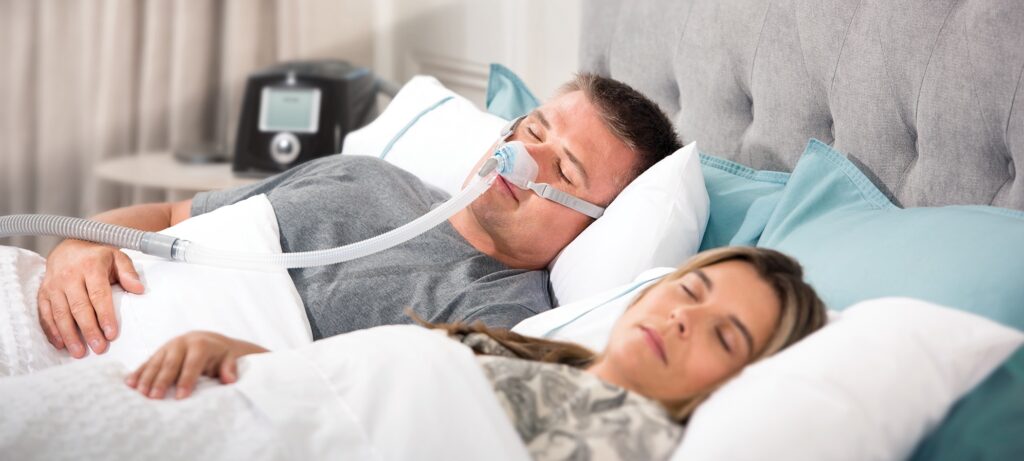This takes place as a result of the relaxation of the muscles at the back of your throat. These muscles provide support for the tonsils, the side walls of the throat, the tongue, and the soft palate. The uvula, a triangular portion of tissue that hangs from the soft palate, also receives support from these muscles.
As the muscles in your airway relax, your airway becomes more constrained or even shuts completely as you take a breath in. Learn more in detail about airway function. Because you are unable to get sufficient air, the oxygen level in your blood may begin to drop. Your brain wakes you up momentarily when it detects that you are unable to breathe in order to give you the opportunity to clear your airway and resume normal breathing. This revelation is often so fleeting that you are unable to recall having experienced it.
Related: Review of the ResMed AirSense 10 Autoset CPAP Machine
You might perhaps snort, choke, or gasp for air. This cycle may repeat itself anywhere from five to thirty times or more each hour throughout the whole night, making it difficult for you to enter the deeper, more peaceful stages of sleep.
Central sleep apnea
This less frequent kind of sleep apnea happens when your brain is unable to send signals to your breathing muscles, causing you to repeatedly stop breathing while you sleep. This indicates that you do not put any effort into breathing for a brief length of time. You may find that you have trouble falling asleep or remaining asleep, or that you have trouble falling asleep in the first place.

Determinants of risk
Sleep apnea may impact people of any age, including children. However, there are a number of variables that raise your risk.
The following are some of the risk factors associated with this kind of sleep apnea:
- Being older: People who are middle-aged or older have an increased chance of developing central sleep apnea.
- Being masculine: The condition known as central sleep apnea is more prevalent in males than in women.
- Heart diseases: Having congestive heart failure raises the likelihood of having a stroke.
- Participating in the use of narcotic pain drugs: A higher risk of central sleep apnea is associated with the use of opioid medicines, particularly those with a lengthy duration of action like methadone.
- Stroke: Your chance of developing central sleep apnea or treatment-emergent central sleep apnea is increased if you have previously had a stroke.
Complications
The medical problem known as sleep apnea is a dangerous one.
Daytime weariness is a possibility when complications arise.
Because of the frequent awakenings associated with sleep apnea, it is hard to get a regular, restorative night’s sleep. This, in turn, increases the likelihood of experiencing significant daytime sleepiness, weariness, and irritability.
It’s possible that you’ll have trouble focusing, and that you’ll find yourself dozing off at work, in front of the television, or even behind the wheel. People who suffer sleep apnea are more likely to be involved in accidents, both on the road and in the job.
You may also have feelings of irritability, depression, or mood swings. It is possible for children and adolescents who suffer from sleep apnea to have behavioral issues or have poor academic performance.
Conditions related to the heart or high blood pressure
The sudden decreases in blood oxygen levels that take place as a result of sleep apnea may cause a rise in blood pressure and put a burden on the cardiovascular system. If you have obstructive sleep apnea, your chance of developing high blood pressure is increased (hypertension).
Obstructive sleep apnea may also raise your chance of having a second heart attack or stroke, as well as irregular heartbeats like atrial fibrillation. If you have heart problems, experiencing several bouts of low blood oxygen levels (also known as hypoxia or hypoxemia) might put you at risk for abrupt cardiac arrest and death.
Type 2 diabetes.
Insulin resistance and type 2 diabetes are both conditions that are more likely to develop in people who have sleep apnea.
Signs of the metabolic syndrome.
This condition, which may be identified by symptoms such as high blood pressure, abnormal cholesterol levels, excessive blood sugar, and an enlarged waist circumference, is associated with an increased likelihood of developing cardiovascular disease.
Complications resulting from the use of drugs or surgery
In addition, there is a risk of developing obstructive sleep apnea while taking certain drugs or undergoing general anesthesia. People who have sleep apnea are more likely to have breathing issues following major surgery, particularly while they are sedated and laying on their backs. This makes it more likely that they will have complications after the procedure.
Talk to your surgeon about your sleep apnea and the treatment you’re receiving for it before you go under the knife.

Liver issues.
People who suffer sleep apnea have a higher risk of having abnormal test results for their liver function, and their livers also have a higher risk of displaying symptoms of scarring (nonalcoholic fatty liver disease).
Sleep-deprived couples.
Snoring that is very loud might prevent anybody who sleeps nearby from enjoying a restful night’s sleep. It is not unheard of for one spouse to need to sleep in a different room or even on a different level of the home due to the presence of their sleeping companion.
Obstructive sleep apnea
- Being overweight is one of the risk factors that might raise the likelihood of developing this kind of sleep apnea. The chance of developing sleep apnea is considerably increased in those who are obese. Deposits of fat around the upper airway might make it difficult for a person to breathe.
- The circumference of the neck: People who have larger necks may have airways that are more restricted.
- An obstruction in the airway. It’s possible that you got your small neck from your parents. In children, the tonsils and adenoids are more likely to become enlarged and restrict the airway than adults.
- Being masculine: The prevalence of sleep apnea in males is about two to three times higher than in women. On the other hand, a woman’s chance of developing breast cancer seems to increase after menopause and increases more if she is overweight.
- Being older: Adults over the age of 60 have a greatly increased risk of developing sleep apnea.
- The history of the family: Your likelihood of developing sleep apnea may be increased if you have a history of it in your family.
- Consumption of sedatives, tranquilizers, or alcoholic beverages: Because the muscles in your throat relax when you take in these medications, your obstructive sleep apnea may become even more severe.
- Smoking: Persons who have never smoked have a much lower risk of developing obstructive sleep apnea compared to people who are current smokers. It is possible for inflammation and fluid retention in the upper airway to become more severe when someone smokes.
- Congestion in the nasal passages: It is more probable that you will develop obstructive sleep apnea if you have trouble breathing through your nose, whether as a result of an anatomical issue or allergies.
- Disorders in the human body: There are a number of illnesses, such as congestive heart failure, high blood pressure, type 2 diabetes, and Parkinson’s disease, that have been linked to an increased likelihood of developing obstructive sleep apnea. Polycystic ovarian syndrome, hormonal abnormalities, a history of stroke, and chronic lung illnesses such as asthma may all increase the likelihood of having polycystic ovary syndrome.
